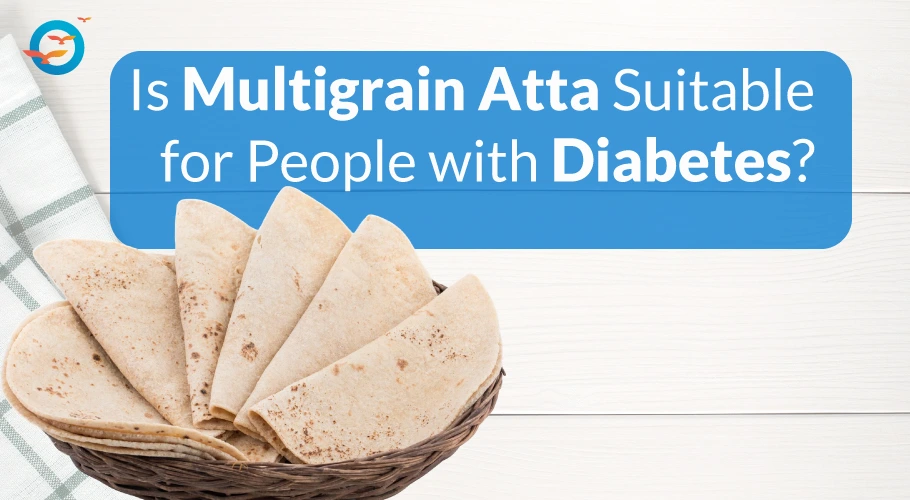Is Multigrain Atta Suitable for People with Diabetes?

Can multigrain atta help in managing blood sugar levels?
Living with diabetes often means paying close attention to what goes on your plate especially when it comes to carbohydrates. Traditional wheat flour, a staple in most Indian households, may not be the best option due to its higher glycemic index. This brings us to a common question: Is multigrain atta suitable for people with diabetes? The short answer is yes, but let’s explore why.
What is Multigrain Atta?
Multigrain atta is a flour made by blending multiple grains such as wheat, oats, barley, maize, ragi, jowar, bajra, and soy. Each grain contributes its own set of nutrients, making the flour more wholesome than single-grain varieties. This diverse grain mix not only improves the flavor and texture of your rotis but also offers several health benefits of multigrain atta.
Understanding Multigrain and Diabetes
The relationship between multigrain and diabetes is rooted in how the body processes carbohydrates. Foods made with refined flours typically cause a rapid spike in blood sugar levels. On the other hand, multigrain atta, especially when made from whole grains, has a low to moderate glycemic index, which helps in slower absorption of glucose into the bloodstream see more on what glycemic index means.
This makes multigrain atta for sugar control a viable option for people managing diabetes. Grains like oats and barley are rich in soluble fiber, which helps stabilize blood sugar levels and improve insulin sensitivity.
Top Benefits of Multigrain Atta for Diabetics
Let’s dive into the multigrain atta benefits that make it especially useful for diabetic individuals:
1. Rich in Dietary Fiber
One of the most important benefits of eating multigrain atta is its high fiber content. Fiber slows down the digestion of carbohydrates and helps in maintaining steady blood sugar levels. It also supports gut health and improves satiety, reducing the urge to overeat.
2. Low Glycemic Index
Whole grains like oats, barley, and millets used in multigrain atta have a lower GI compared to refined wheat flour. This translates to better blood sugar control and reduced risk of sugar spikes post meals.
3. Rich in Protein and Micronutrients
Multigrain atta includes a variety of grains that contribute to its overall nutritional profile. You get a good mix of protein, iron, B-vitamins, and essential minerals that promote energy levels and cellular repair, helping manage the complications of diabetes.
4. Better Heart Health
People with diabetes are at greater risk of cardiovascular issues. Grains like oats and barley are known to help lower LDL cholesterol levels. Regular consumption of multigrain atta benefits heart health by supporting better lipid profiles.
5. Promotes Satiety and Aids in Weight Management
Another often overlooked benefit of multigrain atta is how filling it is. The combination of fiber and protein keeps you fuller for longer. This supports weight loss efforts, which in turn improves insulin sensitivity and glycemic control.
Benefits of Eating Multigrain Roti Daily
Making a switch to multigrain roti is one of the simplest changes a diabetic individual can make. Some of the key benefits of eating multigrain roti include:
- Steady energy release throughout the day
- Reduced hunger pangs
- Improved digestive health
- Lesser dependency on insulin or oral medication (in some cases)
- Greater dietary variety with a mix of grains
These rotis are not only healthier but also more flavorful, making them easier to incorporate into your daily meals.
Choosing the Right Multigrain Atta for Diabetes
While multigrain atta has many upsides, it’s important to check the ingredient list. Many commercial products may contain high amounts of refined wheat flour and very little of the other grains. Look for atta that includes a higher proportion of whole grains like jowar, bajra, ragi, and oats.
Brands that focus on organic or traditionally milled flours may provide better nutritional quality. Some brands, like Diabexy Sugar Control Atta, highlight a low glycemic load (~7) compared to regular wheat atta—making it a model for what to look for when choosing multigrain atta
How to Incorporate Multigrain Atta into a Diabetic Diet?
- Start Slow: Begin by mixing multigrain atta with your regular flour in a 50:50 ratio.
- Stay Consistent: Make it a part of your daily routine swap regular roti, paratha, or even dosa batter with multigrain versions.
- Balance Your Plate: Pair it with high-fiber vegetables, legumes, and healthy fats for maximum benefit.
- Hydrate Well: The fiber in multigrain atta requires adequate water intake to aid digestion and avoid bloating.
Read more about what are diabetes friendly flours, visit our blog.
Frequently Asked Questions
Is multigrain atta good for diabetes?
Yes, multigrain atta made from whole grains like oats, barley, and millets has a lower glycemic index and is rich in fiber, making it suitable for people with diabetes.
Which multigrain atta is best for diabetic patients?
Look for a multigrain atta with a high proportion of whole grains like jowar, bajra, ragi, and oats, with minimal or no refined flour.
Can multigrain atta help with sugar control?
Yes, the high fiber and low GI content in multigrain atta contribute to better sugar control and improved insulin sensitivity.
Is eating multigrain roti daily safe for diabetics?
Absolutely. Eating multigrain roti regularly can support blood sugar management, improve digestion, and help with weight control when paired with a balanced diet.
What is the difference between whole wheat and multigrain atta?
Whole wheat atta is made from a single grain wheat whereas multigrain atta is a blend of various grains, offering more diverse nutrients and health benefits.

